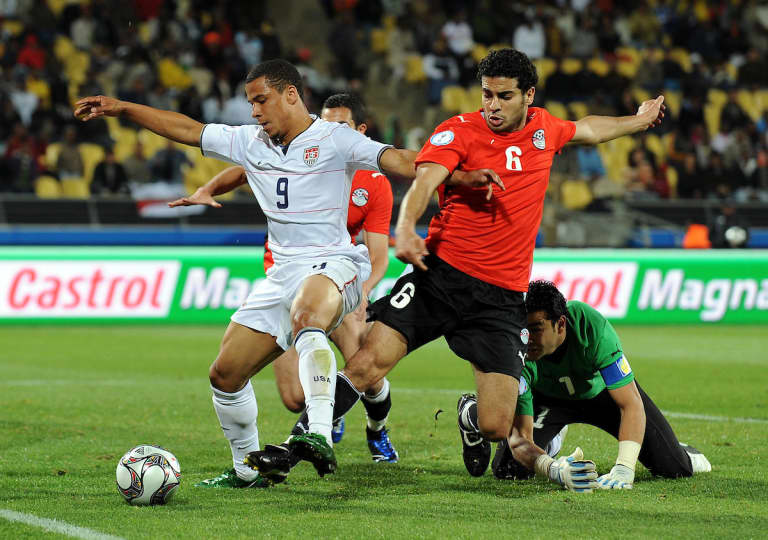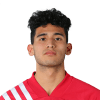As we head into the June friendlies and the Concacaf Nations League for the US men’s national team, one of the main questions still remains: Who will end up leading the line in attack?
USMNT head coach Gregg Berhalter has only called in two outright central forwards for this camp with both options certain to see significant playing time. As I see it there are four players currently in contention for the starting role as striker for the USMNT: FC Dallas’ Jesus Ferreira, new addition Haji Wright, Tim Weah and the absent Ricardo Pepi.
What’s needed to get the job done?
The squad needs a striker who can play against any system and one who can be effective regardless of the tactics Berhalter uses in any given match. This striker will also be responsible for shaping the press as well as creating space for Christian Pulisic, Gio Reyna, and Brenden Aaronson, who often play inverted out in the wings.
I love a striker who can be unpredictable and, in this USMNT setup, having the ability to stretch the opponent relieves pressure on the team. That gives the option for the backline to safely play a ball into the channels to move the lines up, which allows the team to establish possession in the final third and minimizes potential mistakes in the buildup.
The need for quality hold-up play is vital to create mismatches and attacking advantages, particularly given the talented players running off the ball. Lastly, and most importantly, the main responsibility of the No. 9 is to score goals. The more goals that can come off the player leading the line, the less pressure it puts on Pulisic and the other attackers. The USMNT needs a striker who makes hard, decisive runs in the box and can also be an opportunistic player who can finish with both feet.
With that, let’s give a look at the candidates currently available to fill the role at the Qatar 2022 World Cup.
Ferreira is in scintillating form with FC Dallas. In 2022, the 21-year-old attacker has bagged nine goals in just 11 starts. To put it into perspective, Jesus scored just eight goals in both his 2019 (29 starts) and 2021 (26 starts) seasons. The experience of playing in the World Cup Qualifiers coupled with the departure of Ricardo Pepi, who left Dallas for Germany's Augsburg in a $20 million transfer, has paid off for Ferreira.
The concern with Jesus was his ability to run in behind and stretch defenses. When playing with Pepi, he usually dropped deep into midfield to create space for his partner, developing as a connector and a forward who liked to play between the lines. However, playing as the lone striker this season with FC Dallas, he’s showing he’s capable of making those runs behind backlines. The timing of his runs has allowed him to create enough space between himself and the last defender, putting him in a prime goal-scoring opportunity. The confidence is flowing and he’s pushing to claim the spot as his to lose.
Wright is an interesting and potentially exciting addition to the camp. The 24-year-old striker had a fine season in Turkey with Antalyaspor, scoring 14 goals in 32 appearances. He finished in style by scoring nine in his last 10 league matches. Standing at about 6-foot-3, Wright has the size and strength to hold up and link, but can also run the channels effectively to stretch the field.
The one-time LA Galaxy academy player tends to position himself high in between the opposing center backs and has shown he can play effectively with his back to goal. What excites me most about him is his comfort on the ball, his ability to dribble at defenders and his variety of finishes. This camp will be telling about where his technical and tactical qualities lie for Berhalter.
The Lille man has primarily been used as a winger in Berhalter’s system, but with the lack of options who consistently score goals and his ability to make well-timed runs, he could be a real option at striker. Weah has something that none of the other players in the center forward position have, and that is real pace.
Ligue 1's Lille have been a good club for Weah to develop, giving him consistent playing time. He’s been used in different positions, but perhaps playing striker could be the position he excels in. The 22-year-old finished this season with a bang, scoring three goals in his last two matches, including a brace against fourth-placed Rennes. His second goal against Rennes was that of a seasoned striker. He made a well-timed run into the box, leaped and executed a perfect snapped header at the near post.
Jonathan David, Weah’s current teammate and Canadian international, is a wanted man after amassing 28 league goals over the past two seasons. His eventual departure could spell more opportunities for Weah up top, which could give him the push needed to secure a chance as the starting striker for the US in Qatar.
Pepi, who was not called in for this camp, is still in the running for the starting role in Qatar despite his slow start in Germany. The 19-year-old Texan had a disappointing 11 appearances, amounting to 475 minutes and no goals for Augsburg. Still, he has proven himself as the difference-maker the US needs when in form.
His movement and link-up play had been effective as well as his timely goals, which played a role in the US qualifying for the World Cup. He will need a strong preseason and a promising start to the 2022-23 campaign to recapture his once-dangerous form. Fortunately for Pepi, his coach at Augsburg, Markus Weinzierl, has stepped down. Former USMNT player and MLS great Michael Parkhurst mentioned how Weinzierl was a difficult coach to play for and one who doesn’t give time to young players, having played for Augsburg under him. Pepi struggled for playing time under his management.
Having the right mindset
When I first got my opportunity to play for the USMNT under Bob Bradley in 2007, I was not ready. I had shown promise with my 1v1 ability and my pace, but my finished product was not refined enough for club or country. The first touch needed at the highest level demanded excellence and mine needed to improve when the speed of play was at its highest.
My club form had been very inconsistent as I struggled with the demands of training in Europe, where the expectation was to train like your playing time depends on it… because it did. I battled with the weekly schedule, my diet and proper usage of my free time. I didn't win the trust and approval of my teammates with my performances, and I put a lot of pressure on myself to come good for the team with goals.
The pressure grew and pushed me towards a negative mindset. My Hammarby coach finally had enough and called me into his office. After a conversation with Tony Gustavsson, he told me to focus on training hard. He explained how I should not be thinking about playing time and that the training sessions were my matches. Tony also had me stay after each training to work on my game for 30-40 minutes. I would spend my weeks working on finishing crosses, curling shots to the far post, low-driven finishes, first touches and my hold-up play. It proved to be career-changing. I ended my first season as a professional with a hat trick and never looked back.
After my second season in Sweden’s top-flight, I finished with 17 goals in all competitions and felt ready for the next step, securing a transfer to a bigger league in Ligue 1 and a USMNT call-up. I was included in the 23-man roster for the FIFA Confederations Cup in 2009. There wasn’t an expectation for me to get serious minutes, but I believed I just needed one start to make an impact to cement my place on the team. I grabbed the opportunity with both hands.

In the final game of the group stage against Egypt, it all clicked for me. I was in tune with the tendencies of my teammates, and they understood where to find me. I scored 21 minutes into the game, all because I wasn’t going to be denied. On a cross from Jozy Altidore, Egypt’s keeper coughed up a rebound and I reacted to it first. There were two Egyptian defenders converging and I had to use my body to shield the ball and get into position to put a shot on goal. I wanted it more and wasn't going to squander the loose ball. That was the turning point for me.
I recalled that memory just as a reminder that a lot can happen between now and November with the forwards available for the USMNT. Every player develops at their own pace and players can get injured (knock on wood). There are several players who could come into contention with a good run of form, consistency and staying healthy.
If Jordan Pefok (Young Boys) were to secure a transfer to a bigger club in Ligue 1, Bundesliga, La Liga or the EPL and continue to have the same results in front of goal as he did in the Swiss top-flight, then I believe we would likely see him recalled for the World Cup camp. Josh Sargent (Norwich), Daryl Dike (West Brom) and Matthew Hoppe (Mallorca) have all had a bright moment or two, but need to stay healthy, get consistent starts and produce in front of goal. In Hoppe and Sargent’s case, maybe a change of scenery would be beneficial. Jeremy Ebobisse (San Jose) and Brandon Vazquez (Cincinnati) are on a tear in Major League Soccer but, in my opinion, will need to finish the season scoring at the same rate in order to get a look before roster selection.
As the Qatar 2022 World Cup fast approaches, it is sure to be an exciting build-up for US Soccer supporters. This next camp should give us a better indication of who is in the position to lead the attack, but a lot can change and form in the fall heading into the World Cup will be vital.













